- Quick Read
- Deep Read ( 8 Min. )

Why is Christian Science in our name?
Our name is about honesty. The Monitor is owned by The Christian Science Church, and we’ve always been transparent about that.
The Church publishes the Monitor because it sees good journalism as vital to progress in the world. Since 1908, we’ve aimed “to injure no man, but to bless all mankind,” as our founder, Mary Baker Eddy, put it.
Here, you’ll find award-winning journalism not driven by commercial influences – a news organization that takes seriously its mission to uplift the world by seeking solutions and finding reasons for credible hope.
Explore values journalism About usIn Today’s Issue
- The Trump economy: How will tariffs, taxes, and big debt affect workers?
- Today’s news briefs
- With Netanyahu warrant, international court tests priorities of Israel’s allies
- This Thanksgiving, a helping of turkey trivia to gobble up
- Wild animals are disappearing in Latin America. Colombia is fighting back.
- Beyond ‘Green Gables’: A new look at Anne’s creator
Monitor Daily Podcast
- Follow us:
- Apple Podcasts
- Spotify
- RSS Feed
- Download
TODAY’S INTRO
Gabbling and gobbling
Today, Monitor writers explore the implications of International Criminal Court charges and how President-elect Donald Trump’s economic team is taking shape. Then we’ll turn to something far lighter that may be on your mind: Did Ben Franklin really admire turkeys as much as holiday lore sometimes suggests?
Food writer Kendra Nordin Beato tackles that question and share some insights on the most analyzed, pored over, and otherwise parsed meal in the United States. You’ll have plenty to gabble about as you gobble.
Share this article
Link copied.

Help fund Monitor journalism for $11/ month
Already a subscriber? Login

Monitor journalism changes lives because we open that too-small box that most people think they live in. We believe news can and should expand a sense of identity and possibility beyond narrow conventional expectations.
Our work isn't possible without your support.
The Trump economy: How will tariffs, taxes, and big debt affect workers?
President-elect Donald Trump’s economic team will face a minefield of fiscal and economic challenges, with no clarity as to how American workers will fare.

-
Patrik Jonsson Staff writer
As in his first term, Donald Trump has selected two executives with both deep pockets and deep ties to Wall Street to lead the United States’ most important Cabinet posts for the economy – a top concern for American voters.
Markets roared their apparent approval Monday of the Nov. 22 nomination of billionaire hedge fund CEO Scott Bessent for U.S. treasury secretary. Days earlier, the president-elect selected billionaire Howard Lutnick, head of a brokerage and investment bank, as commerce secretary.
“These are more consensus-oriented, market-friendly, business-friendly Cabinet appointments,” says Mark Zandi, chief economist at Moody’s Analytics.
That said, the economic team – and it is not filled out yet – is looking at plenty of fiscal and economic challenges.
On Monday, after U.S. markets closed, Mr. Trump announced that on the first day of his administration, he will impose a 25% tariff on Canadian and Mexican goods and add a 10% tax to Chinese goods – many of which are already taxed.
Economists say China has already accounted for coming tariffs.
“At the end of the day, it’s about jobs,” says Mr. Zandi. “That’s going to be how President Trump’s economic policies are ultimately going to be judged.”
The Trump economy: How will tariffs, taxes, and big debt affect workers?

As in his first term, Donald Trump has selected two executives with both deep pockets and deep ties to Wall Street to lead the United States’ most important Cabinet posts for the economy – a top concern for American voters.
U.S. stock markets rose in apparent approval Monday following the Nov. 22 nomination of billionaire hedge fund CEO Scott Bessent for U.S. treasury secretary. Days earlier, the president-elect selected billionaire Howard Lutnick, head of a brokerage and investment bank, as commerce secretary.
“These are more consensus-oriented, market-friendly, business-friendly Cabinet appointments,” says Mark Zandi, chief economist at Moody’s Analytics. “Investors are OK with these choices, and that’s because they are mainstream.”
That said, the economic team – and it is not filled out yet – faces plenty of fiscal and economic challenges, with no clarity as to how American workers will fare. The incoming president promised in a statement Friday that under Mr. Bessent’s leadership, “No Americans will be left behind in the next and Greatest Economic Boom.”
But of Mr. Trump’s promised tax cuts, some economists wonder: Will they explode government borrowing – and interest rates? Likewise, of Mr. Trump’s promised tariffs, or taxes on imports: Will they trigger higher prices for imported goods? Will they start a trade war?
On Monday, after U.S. markets closed, the incoming president announced that on the first day of his administration, he will impose across-the-board tariffs on America’s biggest trading partners: a 25% tariff on all Canadian and Mexican goods, and a 10% tax on all Chinese goods. Many Chinese goods are already taxed under tariffs imposed in President Trump’s first term and continued in the Biden administration. The new Chinese tariff would be on top of that. It could just be an opening salvo, given that Mr. Trump has talked about a 60% tariff on China.

Mr. Trump said in Truth Social posts that the tariffs are meant to force these countries to crack down on border security, including fentanyl exports.
The tariff announcement was met with disquiet from abroad. Mexican President Claudia Sheinbaum Pardo warned the incoming president that “Neither threats nor tariffs will solve the issue of migration or drug consumption” and said in a letter that Mexico would retaliate in kind if the U.S. follows through. She pointedly reminded him that 70% of illegal weapons seized from criminals in Mexico are from the U.S. “Tragically, it is in our country that lives are lost to the violence resulting from meeting the drug demand in yours.”
In Canada, Ontario Premier Doug Ford called the plan “devastating.” Prime Minister Justin Trudeau phoned Mr. Trump in a brief call focused on border security and trade. His remarks to his Cabinet were measured: “This is a relationship that we know takes a certain amount of working on, and that’s what we’ll do.” Chinese Embassy spokesperson Liu Pengyu said that “no one will win a trade war” and flatly denied that China “knowingly” allows fentanyl precursors into the U.S.
Negotiating tools, but at what cost?
Mr. Trump’s use of tariffs to get what America wants jives with Mr. Bessent’s comments that they are negotiating tools to achieve America’s economic and foreign policy aims. He rejects the claim that they are inflationary, saying there was “no discernible rise in inflation” after the first round of tariffs in Trump 1.0.
“Whether it is getting allies to spend more on their own defense, opening foreign markets to U.S. exports, securing cooperation on ending illegal immigration and interdicting fentanyl trafficking, or deterring military aggression, tariffs can play a central role,” Mr. Bessent wrote in a Nov. 15 opinion piece for Fox News.
America is the world’s largest importer, bringing in $3 trillion worth of goods from other countries. It needs to use that leverage to raise revenue, protect strategic industries, and work out deals with America’s trading partners, he wrote.
Mr. Lutnik sees things similarly. As he puts it, tariffs are “a bargaining chip” to force other countries to lower their import taxes and create a freer market.
Some economists see a solid rationale behind a more assertive U.S. trade policy, given that the current chronic imbalances suggest that “free trade” isn’t the status quo.
“Bessent is right. ... The global trading system is badly broken and needs to be fixed,” Michael Pettis, an economist at the Carnegie Endowment, wrote in a series of posts on the social media platform X Monday.
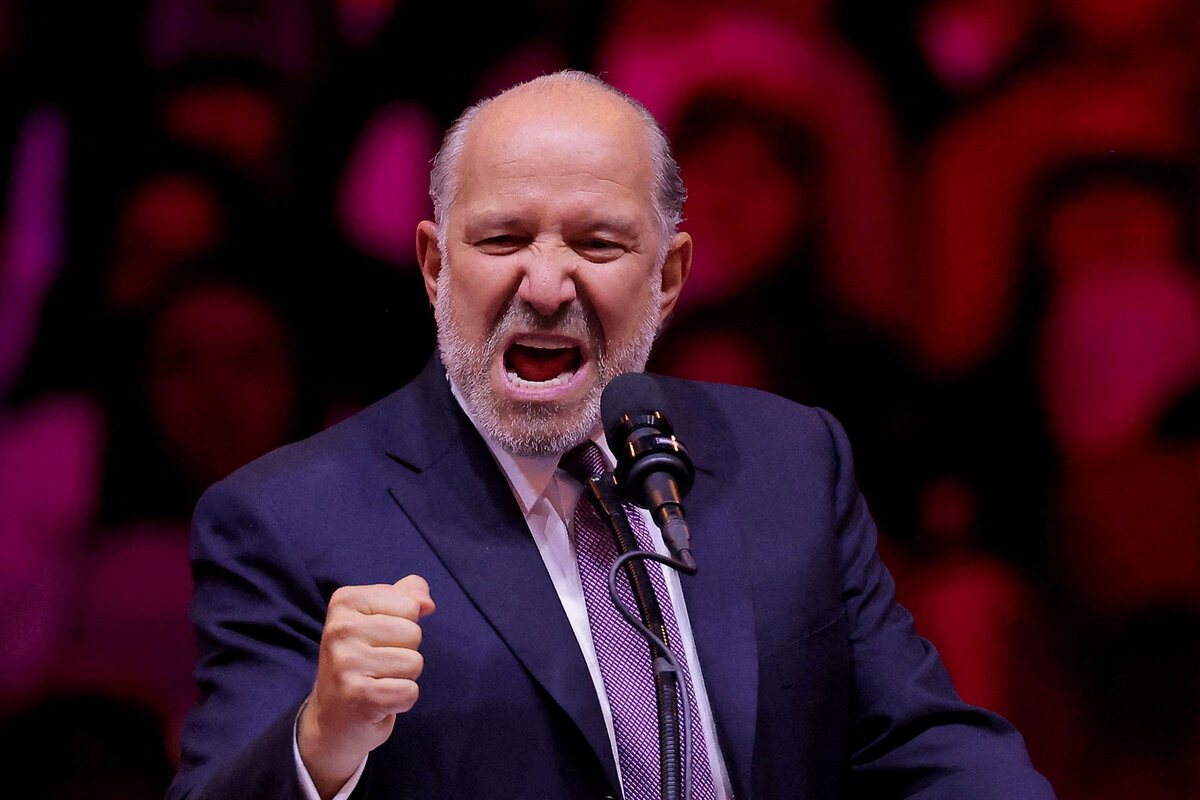
But many economists and other observers are skeptical.
Supply chains have grown more complex
Jack Zhang, the director of the Trade War Lab at the University of Kansas, says China has already accounted for coming tariffs. During his first trip back to China since the pandemic, he encountered a collective shrug as he traveled through that nation’s rust belt this summer.
To be sure, targeted tariffs can be effective, says the political scientist, but global supply chains have grown even more complex since the pandemic, meaning that tariffs have lost political potency while their impacts on consumers and producers remain steady.
“Trench economic warfare is where we are with tariffs and have been there for the last eight years, and the costs have mounted on businesses and consumers,” says Dr. Zhang.
Indeed, “China is a different animal” compared with Mexico and Canada, says Scott Lincicome, vice president of General Economics and Stiefel Trade Policy Center at the libertarian Cato Institute. “The Canada-Mexico thing is totally different. A 25% tariff on everything from Canada and Mexico would have substantial economic ramifications, including on produce. It defies belief that Trump, on the first day, would impose a guacamole tax right before the Super Bowl.”
At the same time, he says, “We should all step away from the ledge on this.” He says the once-and-future president tends to post tariff threats on social media fairly regularly, and then companies and governments “scramble around to find some sort of chit to give him that isn’t substantively important” but allows him to declare victory.
Nonetheless, he warns, “This kind of uncertainty is bad for investment, and it’s bad for the economy.”
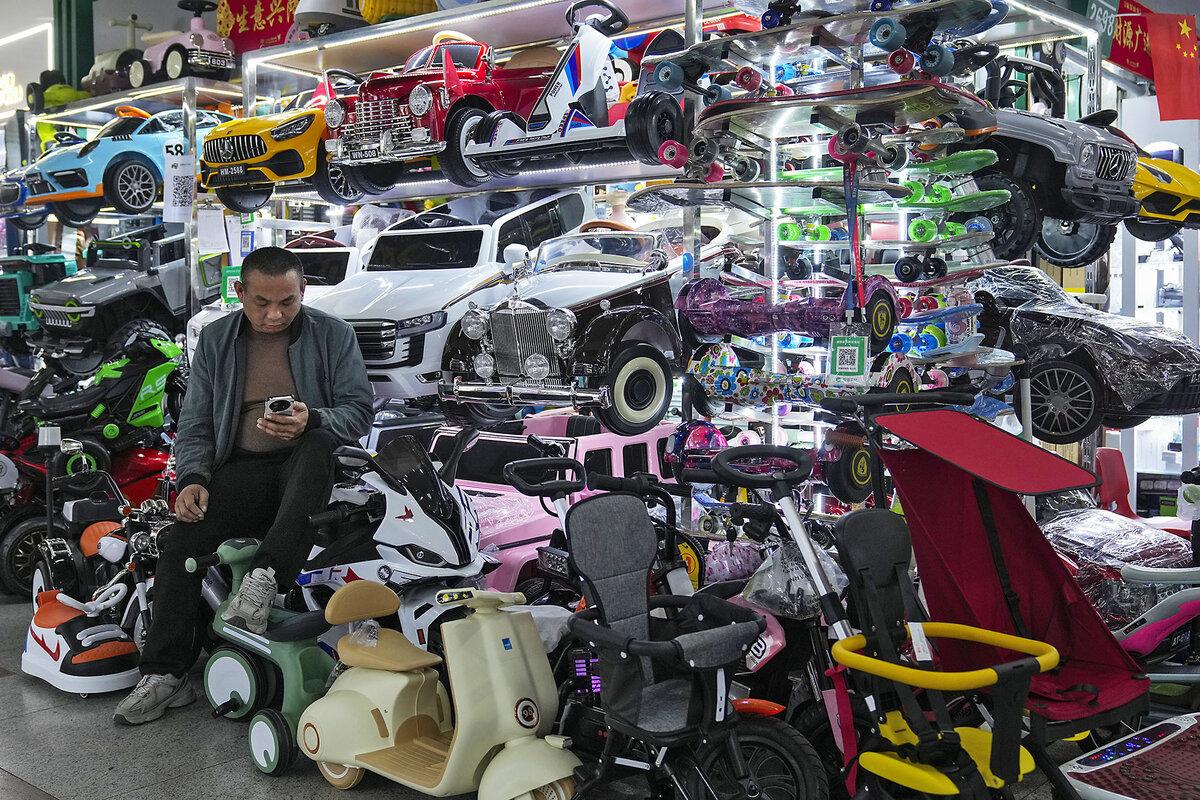
Tax cuts, debt, and interest rates, oh my!
There’s an inherent tension in a tariff strategy, explains Kyle Pomerleau, an economist at the American Enterprise Institute. While Mr. Trump promises to lower consumer costs, he says that tariffs will increase prices. If that fuels inflation and triggers the Federal Reserve to raise interest rates to tamp it down, Americans might find it harder to afford mortgages and car loans.
Similarly, he sees problems with the president-elect’s promise to make permanent his first-term tax cuts – which expire at the end of 2025 – and to lower them further by eliminating taxes on tips, overtime pay, and Social Security. This would lead to more government borrowing, putting upward pressure on prices and higher interest rates – at a time when borrowing is more expensive, warns Mr. Pomerleau. Meanwhile, the nation is set to hit its national debt ceiling next year, with a new ceiling needed to be negotiated with Congress.
“Trump, his administration, and Congress need to tread lightly here,” says Mr. Pomerleau. Because of the incoming president’s campaign promises, “There’s going to be immense pressure to extend the individual tax cuts. There may be additional pressure to cut taxes even further. ... But the fiscal challenges currently make that quite difficult.”
Again, Mr. Bessent sees things differently. In interviews and writings, he argues that cutting taxes and deregulation lead to economic growth, which throws more revenue into government coffers. But he also wants to cut government spending, including subsidies for electric vehicle manufacturers.

He touts a “3-3-3” policy – cutting the budget deficit to 3% of gross domestic product, spurring economic growth to 3%, and producing an additional 3 million barrels of oil a day. He has said that boosting energy output would decrease oil prices, which are the lead driver of inflation expectations. The three-pronged plan is based on a similar one by the late Japanese Prime Minister Abe Shinzo.
The agency he would lead is the most powerful of the federal government’s economic policymaking agencies. The Department of the Treasury carries out tax policy, handles the national debt, leads financial regulators, and controls sanctions – though not directly tariffs, though it has influence (those are handled by the U.S. trade representative, a position not yet filled).
Other members of the president-elect’s named economic team want to drastically reduce the size of the federal government. Russell Vought was nominated to once again lead the Office of Management and Budget. A key figure in The Heritage Foundation’s conservative blueprint, Project 2025, Mr. Vought supports greatly expanded presidential powers, including the ability to withhold monies that Congress has allocated – an idea that Bobby Kogan, of the progressive Center for American Progress, described as “illegal.”
When impoundments like that were adjudicated in the 1970s, “Nixon lost every case that was decided on the merits,” he said in a statement.
Then there are Elon Musk and Vivek Ramaswamy, leaders of the Department of Government Efficiency. The DOGE, as Mr. Musk likes to call it for its allusion to cryptocurrency dogecoin, has no actual authority, though Mr. Musk has big ideas – like cutting about 30% of the federal budget of $6.75 trillion. Medicare and Social Security alone account for about a third of the budget, defense 13%, and 10% on interest for the federal debt. Whatever cuts the administration might propose would need to be worked out with Congress, as they control the nation’s purse strings.
And the American worker?
Economist Mr. Zandi says it’s too soon to tell whether all of this will add up to better lives for working Americans.
Mr. Trump’s nominee for labor secretary, Oregon Republican Rep. Lori Chavez-DeRemer, is staunchly pro-union. Her father was a Teamster, and Teamster President Sean O’Brien welcomes the nomination – even as he writes that it “remains to be seen what she will be permitted to do.”
How tariffs will work out for workers is “way too early” to call, says Mr. Zandi. Equally uncertain is the extent of mass deportations and how deeply they may impact migrant workers in the agriculture sector – and food prices.
“At the end of the day, it’s about jobs,” says Mr. Zandi. “That’s going to be how President Trump’s economic policies are ultimately going to be judged – whether he created more jobs, good paying jobs, union jobs.”
He’s skeptical that the administration’s policies will add up to that. But America is about to find out.

News Briefs
Today’s news briefs
• Israel agrees to ceasefire with Lebanon: Israeli Prime Minister Benjamin Netanyahu said that he was ready to implement a deal with Lebanon and would respond forcefully to any violation by Hezbollah. The accord is expected to take effect Wednesday.
• Trump case dismissed: A U.S. judge dismissed the federal criminal case accusing Donald Trump of attempting to overturn his 2020 election defeat.
• Hong Kong LGBTQ+ rights: Hong Kong’s top court has upheld earlier rulings that favored the granting of subsidized housing benefits and equal inheritance rights to same-sex couples.
• Georgians boycott: The newly elected Parliament opened its inaugural session as thousands of protesters rallied outside, causing opposition lawmakers and the country’s president to stay away.
• March on Islamabad: Supporters seeking the release of imprisoned Pakistani former Prime Minister Imran Khan broke through a ring of shipping containers blocking off the capital and battled security forces.
• Airport strikes: Workers who clean airplanes, remove trash, and help with wheelchairs at the Charlotte, North Carolina, airport walked off the job Monday during a busy Thanksgiving travel week to demand higher wages.

The Explainer
With Netanyahu warrant, international court tests priorities of Israel’s allies
The International Criminal Court’s warrants for Benjamin Netanyahu and Yoav Gallant in theory only target two Israeli leaders. But they also create tensions across a net of Western allegiances, especially in Europe.
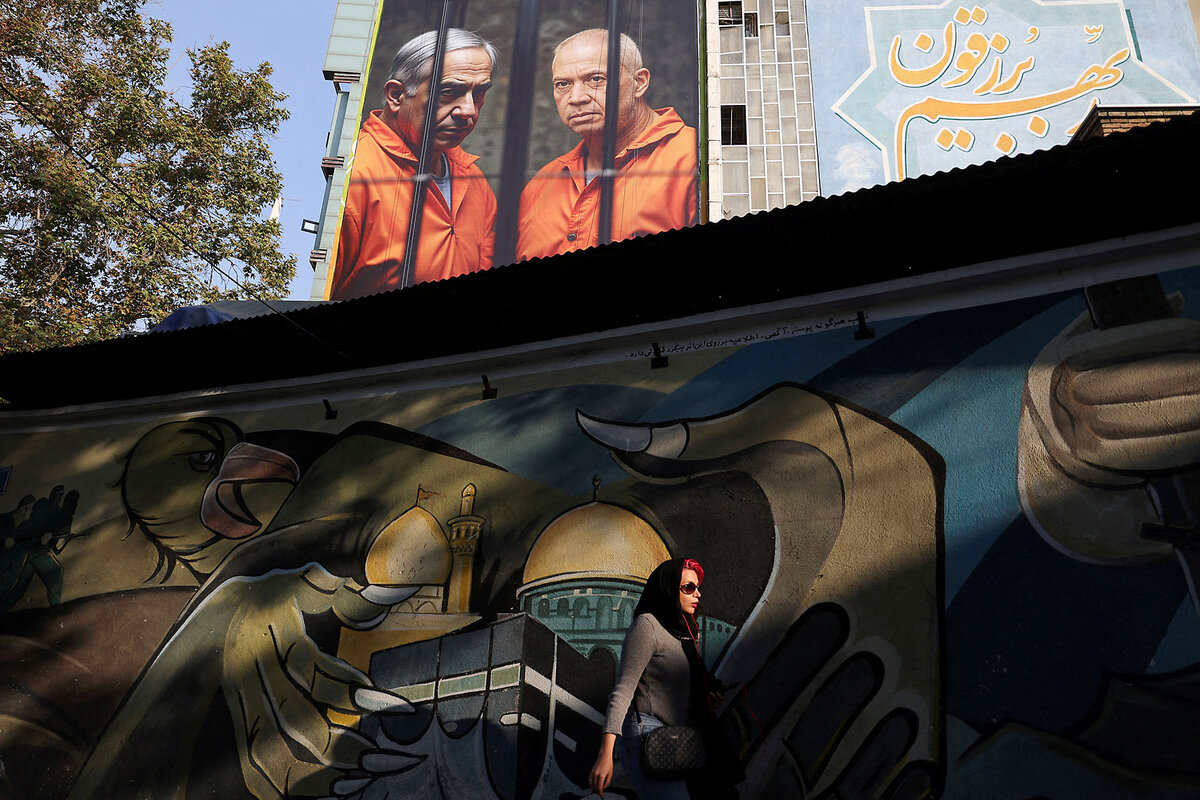
- Quick Read
- Deep Read ( 5 Min. )
The decision by the International Criminal Court at The Hague to issue arrest warrants for Israeli Prime Minister Benjamin Netanyahu and former Israeli Defense Minister Yoav Gallant raises the stakes for Israel’s leadership as it wages its war in Gaza.
The radical step by such an influential legal body creates political and legal concerns for both Israel and its allies, particularly in Europe, who must reconcile their commitment to a rule-based international order with their support for Israel.
All 27 member states of the European Union are backers of the ICC. This places European nations in a delicate position of needing to balance their commitment to international law against any support they extend to Israel.
EU foreign policy chief Josep Borrell stated that the ICC warrants against Israel’s prime minister and former defense chief should be “respected and implemented.” Hungarian Prime Minister Viktor Orbán criticized the warrants as “outrageously impudent” and “cynical.”
“It is a judicial and political bombshell for all involved. The question is how it will play out,” says political scientist Anders Persson. “It could have major repercussions for how European states deal with Israel, but it could also be that not much will happen.”
With Netanyahu warrant, international court tests priorities of Israel’s allies
The decision by the International Criminal Court (ICC) at The Hague to issue arrest warrants for Israeli Prime Minister Benjamin Netanyahu and former Israeli Defense Minister Yoav Gallant raises the stakes for Israel’s leadership as it wages its war in Gaza. The radical step by such an influential legal body creates political and legal concerns for both Israel and its allies, particularly in Europe, who must reconcile their commitment to a rule-based international order with their support for Israel.
What is the ICC for?
The ICC was created in 2002 to prosecute individuals for the world’s worst crimes, including genocide and crimes against humanity.
The court’s jurisdiction encompasses breaches of the Geneva Conventions, which lay out rules for the conduct of war, and apartheid, making it a potentially important arena for judging crimes committed in the Israeli-Palestinian conflict. The ICC has jurisdiction in any state that has ratified the Rome Statute, the agreement which created the court. Major powers Russia, the United States, and China are not Rome Statute signatories. Israel is also not a signatory, but Palestine did join the agreement in 2015.
The court is meant to hold perpetrators accountable, regardless of rank – be they presidents, generals, or rebel leaders – when their own countries’ courts are unable or unwilling to do so. Its focus is on establishing individual responsibility, unlike the International Court of Justice, also based at The Hague, which is concerned with state responsibility.
Before the ICC, serious international crimes were addressed by specialized tribunals. Examples include the Nuremberg trials, which prosecuted top Nazi officials after World War II, and various ad hoc tribunals set up by the United Nations over the Yugoslav War and the Rwandan genocide. But these were seen as insufficient, and gave rise to global support for the creation of a permanent court.
To date, the ICC caseload has focused primarily on atrocities in Africa. Judges have issued 59 arrest warrants, 11 convictions, and four acquittals. Prosecutors have recently turned their attention to Russia’s crimes in Ukraine.
What is the scope of the new arrest warrants?
On Nov. 21, the court issued arrest warrants for Israeli Prime Minister Benjamin Netanyahu and his former defense minister, Yoav Gallant, for alleged crimes committed since last year’s Hamas attack on Israel. Three judges unanimously agreed there are “reasonable grounds to believe” that Mr. Netanyahu and Mr. Gallant “bear criminal responsibility” for the war crime of starvation as a method of warfare and crimes against humanity since Oct. 8, 2023.
“It is a milestone in the pursuit of justice for Palestinians,” says Fiona Thorp of the international crimes and accountability team at the European Center for Constitutional and Human Rights. “At minimum, these arrest warrants will make it difficult for Netanyahu and Gallant to travel to the 124 state parties to the ICC, where they will face a threat of arrest.”
The warrants will make it harder for Israel to carry out diplomacy.
The ICC judges also issued an arrest warrant for Hamas military commander Mohammed Deif. Mr. Deif is believed to have been killed by an Israeli air strike in Gaza in July.
How likely are they to be arrested and what happens if they are?
The warrants depend on Rome Statute signatories to be executed, and states’ responses can vary. Russian President Vladimir Putin, who is wanted by the ICC for alleged crimes in Ukraine, defied the warrant by visiting Mongolia in September, but did not risk a visit to South Africa in 2023.
“There is little prospect that Netanyahu or Gallant will appear before the dock of the ICC in the foreseeable future,” says Anthony Dworkin, senior policy fellow at the European Council on Foreign Relations. “Even if Netanyahu lost power, it is hard to see a successor government handing him over. ... Nevertheless, in the longer term, they cannot be sure that unforeseen events will not ultimately lead to their being handed over.”
If the Israeli officials were arrested, they would be sent for detention at The Hague. There they would have the chance to contest the charges in the pre-trial phase. Three court judges would oversee any resulting trial. If convicted, Mr. Netanyahu and Mr. Gallant would only face prison time – the ICC does not use the death penalty – which would be served in a country willing to host them.
What are the implications for Israel’s allies?
The ICC arrest warrants mark the first time a sitting leader of a major Western ally is accused of war crimes and crimes against humanity by an international court that has broad global support.
Israel’s biggest ally is Washington, which has refused to join the ICC. President Joe Biden condemned the warrants against Israeli officials as “outrageous,” while his successor, Donald Trump, is threatening sanctions against ICC officials.
But all 27 member states of the European Union are backers of the ICC. This places European nations in a delicate position of needing to balance their commitment to international law against any support they extend to Israel, a particularly sensitive issue for Germany due to historical reasons.
EU foreign policy chief Josep Borrell stated that the ICC warrants against Israel’s prime minister and ex-defense chief should be “respected and implemented.” Prime Minister Viktor Orbán criticized the warrants as “outrageously impudent” and “cynical,” and extended an invitation to Mr. Netanyahu to visit Budapest.
Germany, a key weapons exporter to Israel and a champion of universal principles of justice, is “examining” the implications of the warrant. Italy, Ireland, Belgium, the Netherlands, and France have expressed willingness to act on the warrants.
“It is a judicial and political bombshell for all involved. The question is how it will play out,” says Anders Persson, senior lecturer at Linnaeus University in Växjö, Sweden. The ruling – and the fact that the crimes in the warrant are potentially ongoing – raises the risk of complicity for countries that supply weapons to Israel and could pave the way for sanctions against Israel.
“The ICC ruling will probably increase sanctions against Israel, both overt and covert, especially regarding weapons exports,” says Dr. Persson.
Still, he adds, past moves by the international community to influence Israel’s policies, like a 2016 U.N. Security Council resolution condemning settlement activity, haven’t changed much. So the court’s decision to issue warrants may not significantly alter the situation.

This Thanksgiving, a helping of turkey trivia to gobble up
On this American holiday, it’s worth pausing to reflect on the significance of turkeys, the mainstay of the Thanksgiving table.

- Quick Read
- Deep Read ( 5 Min. )
Let’s talk turkey. How did this large fowl, which has paraded unchallenged for centuries as the holiday centerpiece, come to be synonymous with an iconic American tradition? Expand the story for some turkey trivia to share around the table.
This Thanksgiving, a helping of turkey trivia to gobble up

Let’s talk turkey. How did this large fowl, which has paraded unchallenged for centuries as the holiday centerpiece, come to be synonymous with an iconic American tradition? Read on for some turkey trivia to share around the table.
How much turkey do Americans eat?
Farmers in the United States raise 210 million to 215 million turkeys a year, says Leslee Oden, CEO of the National Turkey Federation. The highest-producing state is Minnesota (with 37 million birds), followed by North Carolina and Arkansas.
Over the Thanksgiving holiday alone, Americans will dine on about 40 million pounds of turkey, says Ms. Oden. In 2023, Americans ate more than 5 billion pounds of turkey, about 15 pounds per person, according to the U.S. Department of Agriculture.
Where are turkeys from?
Wild turkeys are indigenous to North America, having foraged their way from Central America up to eastern Canada. They were domesticated in Mexico by the Aztecs, who roasted the guajolote on a large spit and used its feathers to decorate clothing and blankets. Spaniards brought the bird back to European trading markets in the 1500s, where it soon found its way to fancy English dinner parties. Wealthy English, who loved to impress guests with exotic birds as the meal’s centerpiece, named the fowl after the far-off place some merchants had carted it from: Turkey. The name stuck.
Didn’t Benjamin Franklin think the turkey should be the national bird?
Not exactly. Remember that Franklin was a satirist. In January 1784, Franklin privately wrote to his daughter, Sarah Bache, “For my own part I wish the Bald Eagle had not been chosen as the Representative of our Country.” In context, Franklin was critiquing a rather dumpy drawing of an eagle lacking a regal beak by the Society of the Cincinnati, which had adopted the nation’s bird as its symbol. The national punch line was that the Cincinnati eagle looked more like a turkey. In short, think of Franklin’s letter to his daughter as an early dad joke. (Hear more about that in a podcast conversation with Kendra at the bottom of this article.)
Why is turkey associated with Thanksgiving?
The only existing eyewitness account of diplomatic talks between the settling English and the Wampanoag tribe is a 1621 journal entry that includes numerous references to bagging “fowl,” which came to be interpreted as the roaming “turkey.” A century on, “turkey” appeared firmly rooted in American culinary literature and practices. Amelia Simmons’ 1796 “American Cookery,” widely considered the first American cookbook, includes instructions on how “to stuff and roast a Turkey, or Fowl.” In 1827, novelist Sarah Josepha Hale romanticized the role of the turkey in “Northwood: A Tale of New England,” in which she described the ideal Thanksgiving dinner: “The roasted turkey took precedence on this occasion, being placed at the head of the table; and well did it become its lordly station.”
Later, Hale launched a letter-writing campaign to politicians, imploring them to make the Northeast tradition of a Thanksgiving feast a nationwide holiday. She is largely credited with influencing Abraham Lincoln to declare a National Day of Thanksgiving and Praise in 1863 amid the Civil War.
Why does the president pardon turkeys?
It’s unclear which president first officially pardoned a turkey – some say it was Lincoln, who turned a turkey into a family pet. Others say it was John F. Kennedy. Regardless, for the past 76 years, the National Turkey Federation has been delivering a live turkey to the White House. George H.W. Bush officially made the pardon an annual event.
The National Turkey Federation chairman has the honor of keeping the “presidential flock.” Two turkeys are selected from the flock for the voyage to Washington, explains Ms. Oden, in case the official turkey gets stage fright. To prepare for the trip, the turkeys are carefully tended by the farmer, who exposes them to camera lights, pompoms, music, and crowds. Then comes an informal beauty pageant to select the finest turkey in the land. “It’s the one that ultimately struts around the best, has the most beautiful feathers, and really most important is their temperament,” says Ms. Oden. “They are going to go meet the leader of the free world, and we want to make sure that they act on their best behavior.”
This year, turkeys Peach and Blossom traveled from a Minnesota farm by private coach. After arriving in Washington, they stayed in a hotel suite at the Willard InterContinental to rest up for their big moment. Later, it’s back on the coach for the trek home to Minnesota, where they will live out their lives at Farmamerica, an educational farm, as feathered ambassadors.
A Chatty Thanksgiving Primer
Fresh cranberries or canned? Northern pumpkin pie or Southern sweet potato pie? An assembling of intergenerational family members, a handful of friends, or a group of strangers? Almost everything about Thanksgiving, from travel to table talk about politics, has the potential to become fraught. Calm can prevail when a simple sense of gratitude gets its place at the table. The Monitor’s Kendra Nordin Beato joins host Clay Collins to talk turkey and more.

Wild animals are disappearing in Latin America. Colombia is fighting back.
Latin America’s animal populations have fallen drastically over the past 50 years. Will recapturing trafficked animals be enough to rewrite the future of wildlife?
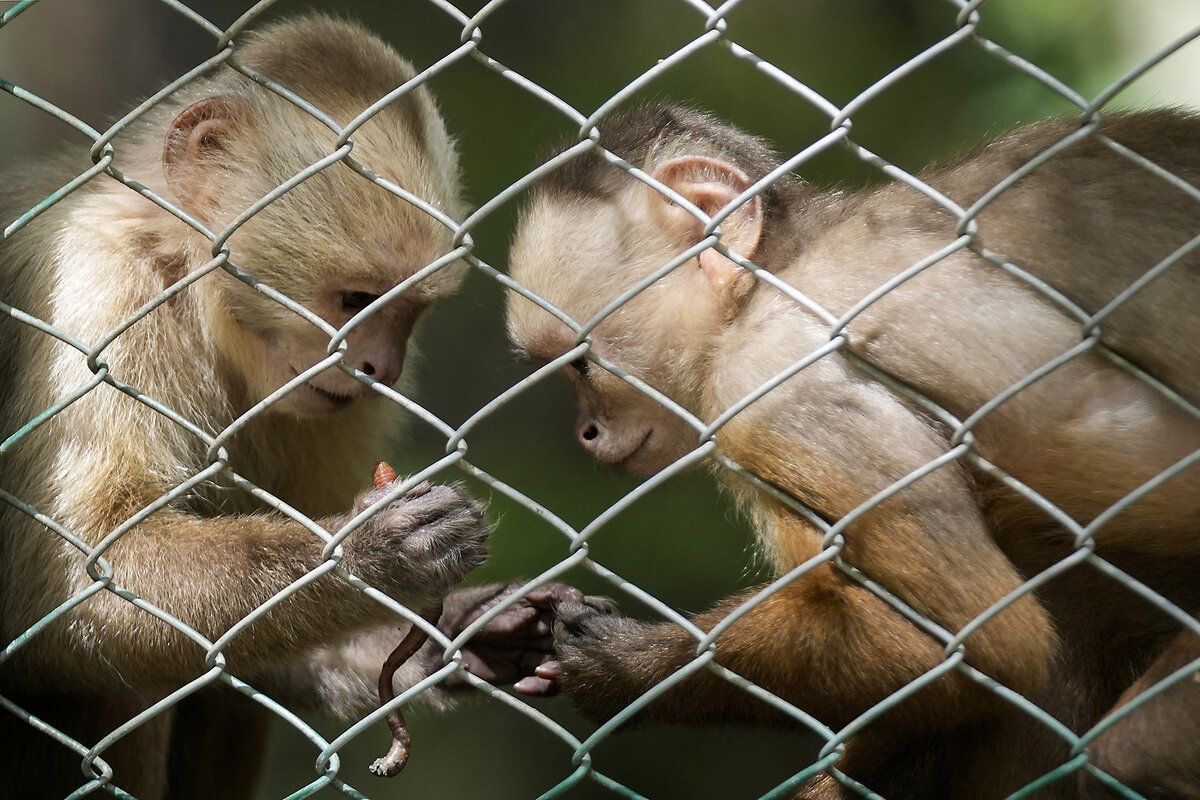
- Quick Read
- Deep Read ( 5 Min. )
-
By Mie Hoejris Dahl Contributor
Latin America is home to around 40% of the planet’s species, but it has suffered some of the most significant losses in the world. Animal populations in Latin America and the Caribbean plummeted by almost 95% over the past 50 years, according to a 2024 report by the World Wildlife Fund and Zoological Society of London. While extractive activities like agriculture, mining, and logging threaten natural habitats, animal trafficking is also to blame. Even as animals are rescued from traffickers, they frequently can’t reintegrate into their natural habitat.
Wildlife trafficking generates an estimated $23 billion annually worldwide, making it the fourth-largest source of criminal profits. The profit margins are high and penalties low. Local poachers bear the brunt of enforcement – in Colombia the law says you can be sentenced to 12 years for capturing endangered species. Meanwhile, traffickers who move the animals internationally profit from selling them for fashion, for traditional remedies, and as exotic pets.
But local communities, governments, and academics across the region are teaming up to try to put a halt to these disturbing statistics.
Humans are the greatest predators of all, says María Rosario Chicunque Chindoy, an Indigenous Kamëntšá woman from Colombia.
Wild animals are disappearing in Latin America. Colombia is fighting back.
La Negra, a jaguar, paces and hisses in her cage at a remote environmental observatory in the lush jungle of southwestern Colombia. Jaguars, fiercely strong cats native to the Americas, are known as kings of the jungle. But La Negra grew up in a cage and will probably die in one, too.
Likely born into captivity or captured by traffickers at a very young age, she was brought to the center by Colombia’s environmental police in 2015 when she was still a cub. She’s too comfortable being around humans, a reason she can never be set free.
But situations like hers, of trafficked animals being located or turned over and scientists figuring out what comes next, are at the heart of what’s motivating communities, researchers, and governments to try to halt Latin America’s startling rates of wildlife loss and trafficking that have taken place here over the past 50 years.
Latin America is home to around 40% of the planet’s species and to the biggest tropical rainforest, the Amazon. But it has suffered some of the most significant losses in the world: Animal populations in Latin America and the Caribbean plummeted by almost 95% over the past half-century, according to a 2024 report by the World Wildlife Fund and Zoological Society of London. (Africa, by comparison, had a 76% decline.) While extractive activities like agriculture, mining, and logging threaten natural habitats, animal trafficking is also to blame.
Humans are the greatest predators of all, says María Rosario Chicunque Chindoy, an Indigenous Kamëntšá woman from Valle de Sibundoy in Colombia’s Putumayo state. Trafficking wild species “generates a spiritual and emotional disequilibrium for us,” because each animal plays an important role in nature, she says.
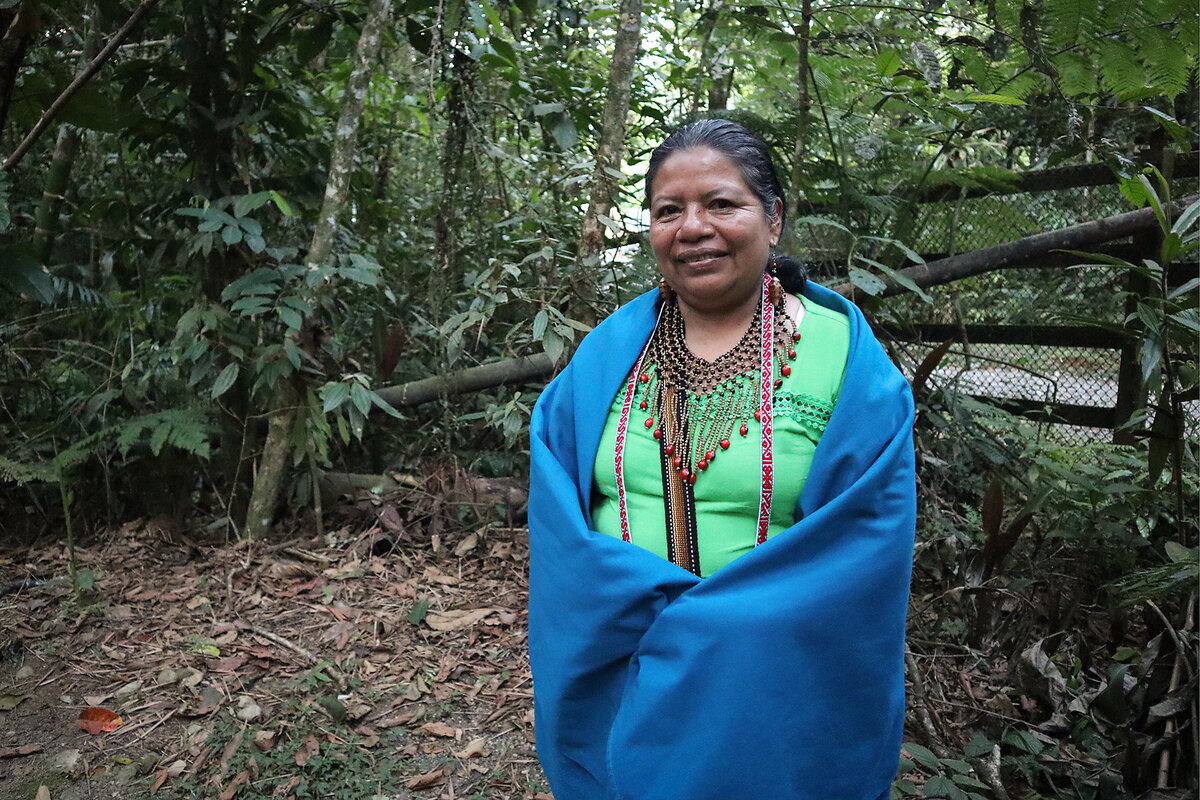
More than conservation
When a woman from Brazil’s Amazonas state, which borders Colombia, first contacted Colombian environmental police about La Negra, she explained that a man whom she didn’t know well had asked her to keep the jaguar cub at her home for one day as a favor. It’s a common tale in the region where hundreds of animals are trafficked each year, affecting animal populations, compromising the health of local ecosystems, and often nurturing criminal networks.
Wildlife trafficking generates an estimated $23 billion annually worldwide, making it the fourth-largest source of criminal profits, behind drug trafficking, counterfeiting, and human trafficking. Wildlife trafficking is appealing because of the high profit margins, low penalties, and minimal risk of prosecution. Local poachers often bear the brunt of law enforcement – in Colombia the law says you can be sentenced to 12 years for capturing endangered species. Meanwhile, traffickers who move the animals internationally often profit from selling them for fashion, for traditional remedies, and as exotic pets without consequence.
The skins, feathers, and bones of endangered species such as jaguars, Andean condors, spectacled bears, and scarlet macaws are in high demand on the black market, according to the Colombian Ministry of Environment. Wildlife trafficking between South America and Asia is estimated to have doubled over the past decade, according to Wildlife Conservation Society.
Several Latin American countries, like Colombia, have escalated wildlife trafficking to a red-alert national security issue as links to transnational criminal groups have grown more evident. That allows for stronger crackdowns on traffickers, says Robert Muggah, founder of Igarapé Institute, a Brazil-based security and development think tank.
Although Colombia has tightened its legislation and penalties, established a Cybersecurity Capacity Center to conduct online patrols, and launched educational campaigns, such as giant billboards warning about the consequences of trafficking, overcoming the damage that’s already been carried out when an animal is trafficked is a challenge of its own.

Collaboration – and measured hope
Saving wildlife is a collaborative effort, says Mayerly Jhoana Delgado, a young biologist at the Amazon Experimental Center (known by its Spanish acronym, CEA) in Putumayo, in southeastern Colombia. She stands in the baking sun chatting to her colleagues – biologists, veterinarians, educators, and engineers – as fish leap from the water surrounding the floating pavilion upon which they stand. Her team at CEA works closely with Colombia’s rural and environmental police unit, Carabineros, as well as with academics who investigate wildlife and local communities that voluntarily hand over species that may have ended up in their care – no questions asked.
Last year, the Carabineros rescued three trafficked animals every hour on average and dismantled 34 criminal organizations involved in wildlife trafficking, according to government data. The unit’s efforts include patrols to detect online trafficking and inspections of markets, airports, ports, pet shops, and courier companies.
Ms. Delgado also collaborates with colleagues in other Amazonian countries, sometimes sharing pictures of unknown animals that arrive at the center to get input on the animals’ possible origin. The CEA has received hundreds of animals over the past nearly four decades, including alligators, macaws, turtles, and snakes.
In this work, one of Ms. Delgado’s biggest fears is the wrongful reinsertion of an animal, which can pose a threat to the animal’s survival as well as to humans in the vicinity. Central to a successful reentry into nature is making sure that captured animals don’t bond with human beings, says Abelardo Rodríguez Bolaños, a professor specialized in biodiversity management at Francisco José de Caldas District University in Bogotá.
Even once they are in the care of a center like CEA, the scientists must stay vigilant. “Every day in captivity, we get closer” to making it impossible to return an animal to their natural habitat, Mr. Rodríguez says. Strategies to keep animals wary include disturbing them with noises, smells, or even mild electric shocks that make them want to avoid humans.
“Everyone loves liberating animals,” he says, “but without proper [preparations], it can lead to worse outcomes.”

Beyond ‘Green Gables’: A new look at Anne’s creator
Who was L.M. Montgomery, beyond the writer of a beloved literary character? On the 150th anniversary of the author’s birth, Prince Edward Island is urging a broader understanding.
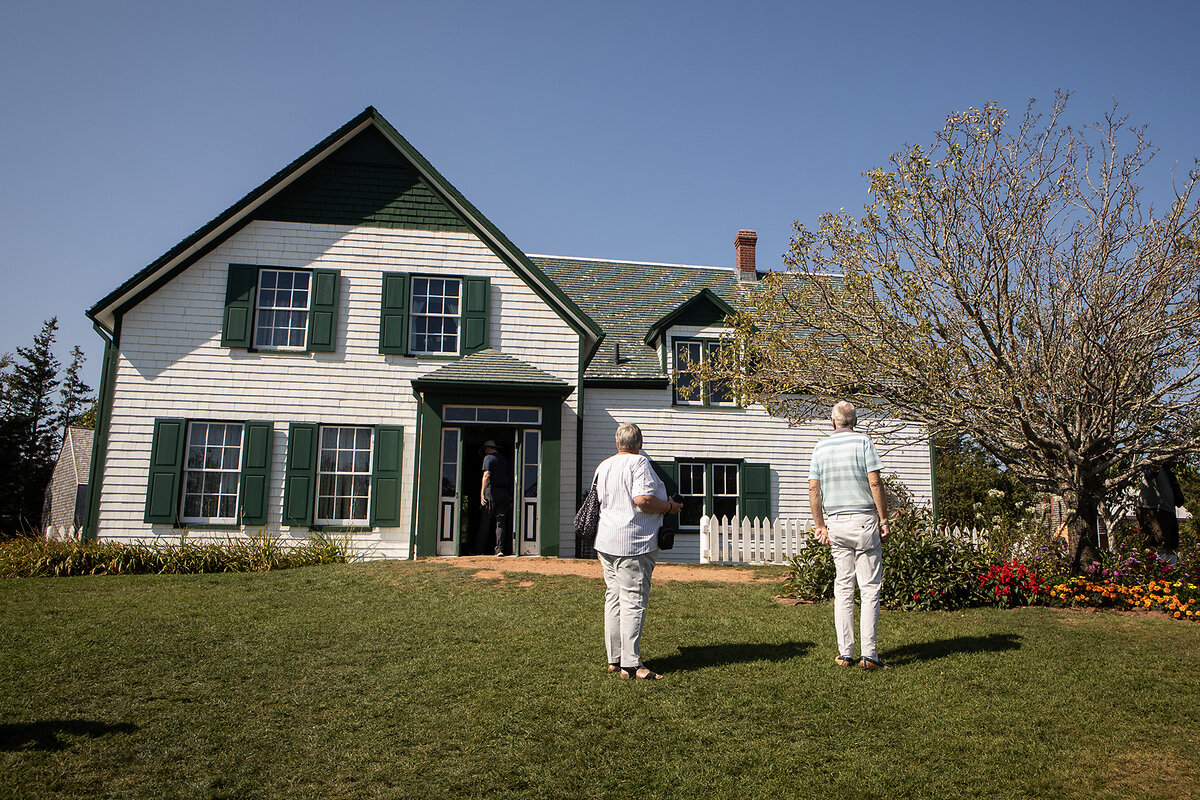
- Quick Read
- Deep Read ( 5 Min. )
-
Melanie Stetson Freeman Staff photographer
For a century, the farmhouse on Prince Edward Island that inspired the setting of “Anne of Green Gables” has lured fans eager to retrace the footsteps of their favorite redheaded literary character.
But the Victorian farmstead is not just a capsule suspended in time. It welcomes a diverse fan base whose members see themselves in the foibles of the impetuous orphan who finds love and family.
“Anne of Green Gables” has sold more than 50 million copies and been translated into over 30 languages. The headstrong 11-year-old is one of the most beloved children’s characters of all time. Ultimately, it’s a story about an outsider finding acceptance – a lesson that, if anything, resonates more today than ever.
And with the 150th anniversary of author Lucy Maud Montgomery’s birth on Nov. 30, there are plenty of visitors to these red-sanded shores. Many people see the anniversary as an opportunity to more intentionally shift the conversation beyond just the “pastoral prettiness” of the story. They aim to examine the wider world the character would have inhabited and to consider Montgomery and her work with a 21st-century eye toward inclusion and diversity.
Beyond ‘Green Gables’: A new look at Anne’s creator
The white-shingled home with a green-gabled roof is perched timelessly amid the rolling pastures of Prince Edward Island.
For a century, the farmhouse, which inspired the setting of “Anne of Green Gables,” has lured fans eager to retrace the bucolic footsteps of their favorite redheaded literary character. Visitors snap photos of patchwork quilts and rocking chairs. They wander the forest groves that Anne – with an e – who was so fiercely imaginative about the natural world around her, renamed the “Haunted Woods.”
But the Victorian farmstead is not just a capsule suspended in time. It welcomes a diverse fan base whose members see themselves in the foibles of the impetuous orphan who breaks all the rules but finds love and family.
“Anne of Green Gables” has sold more than 50 million copies and been translated into over 30 languages. The headstrong 11-year-old who was sent by mistake to live on a farm is one of the most beloved children’s characters of all time.


“[Author Lucy Maud Montgomery] is looking at the world and seeing people’s foibles and imperfections, yet holding them up affectionately and loving them anyway,” says Laura Robinson, a professor at Acadia University who chairs the L.M. Montgomery Institute management committee. “There are people who find any time they are in a tough place in their life, they really want to reread these because there’s something healing and redemptive about them.”
Ultimately, it’s a story about an outsider finding acceptance – a lesson that, if anything, resonates more today than ever.
And with the 150th anniversary of Montgomery’s birth on Nov. 30, there are plenty of visitors to these red-sanded shores. Many people see the anniversary as an opportunity to more intentionally shift the conversation beyond just the “pastoral prettiness” of the story. They aim to examine the wider world the character would have inhabited and to consider Montgomery and her work with a 21st-century eye toward inclusion and diversity.
“Don’t get me wrong, we love Anne,” says Linda Lowther, a tourism and education consultant touted as the island’s “Montgomery at 150” expert. She is part of an effort to highlight new tours and tributes that educate visitors about the creator of Anne, not just the character.

Many of those events are exactly the kind one might expect on an island that can sometimes feel as if it jumped out of a storybook: floral scrapbooking, journaling workshops, musicals, concerts created with Montgomery poems, and the chance for children to be taught in a re-created classroom.
But Montgomery, the writer of hundreds of short stories and 20 novels, was also a woman ahead of her time. She broke barriers and turned Anne into one of Canada’s most cherished, and lucrative, icons.
“She was a fierce environmentalist. I heard someone say she had the business acumen of Taylor Swift,” says Ms. Lowther.
She also had a complex life. Montgomery based the story of Anne in part on her own upbringing, after her mother died and her father left her with her stern grandparents in Cavendish on the north shore of the island. Throughout her life, she struggled with depression, and some of that trauma is found in her writing.
“[The story] is often represented as kind of fluffy and happy happy, but it can be scathing in moments,” says Dr. Robinson.


“More than one single narrative”
Anne has always appealed to a diverse set of readers. The Japanese are counted as some of her most devoted fans; Aretha Franklin famously considered Anne a “kindred spirit.”
But Montgomery today is being examined for blind spots. Her series, for example, ignores the Indigenous inhabitants of Prince Edward Island, who arrived thousands of years before European settlers. That storyline was explored in Netflix’s “Anne with an E,” when Ka’kwet, a Mi’kmaw character, befriends Anne.
Parks Canada, which runs Green Gables Heritage Place, this year released a 10-year management plan to “engage with Indigenous and marginalized communities to tell their stories.” Already, the site, which saw 165,000 visitors last year, includes panel information (some of it in Mi’kmaw language) about Indigenous history at the time “Anne of Green Gables” was published in 1908.
Parks Canada is also looking forward, considering the visitor experience in a more multicultural contemporary Canada. Prince Edward Island’s capital, Charlottetown, is among the fastest growing Canadian cities, thanks to immigration.

Their management plan, still abstract, has nothing to do with changing the story, says Janette Gallant, with Parks Canada. “It has to do with reflecting the diversity of Canadian society and understanding there are more stories and more voices to be heard ... more than one single narrative.”
That’s the force that drove Judith Graves to create “The ANNEthology: A Collection of Kindred Spirits Inspired by the Canadian Icon.” In a collection of short stories, “Anne” is reimagined as a robot in one, a girl from Jamaica who’s been trafficked in another. “The idea was to take this universal character and see how she can shift in different cultures with different genders and in different time periods,” says Ms. Graves.
The local author has received some pushback from those defensive about “their island treasure,” she says.
“Just leave her alone,” she heard.

“I feel like I’m Anne”
A visit to Green Gables Heritage Place should assuage anyone worried about an overmodernization of the storyline: The “kindred spirit” that many feel with Anne is enduring.
“I try to explain,” says Harriet Nicholson, an Australian on a 10-day trip of a lifetime. “I am Anne. I feel like I’m Anne.”
It’s more than just their shared red hair, or the “scrapes” that both got into as youngsters. When Ms. Nicholson would be late getting home as a child, her mother always knew to look “up” in the trees instead of “down.” At first, she didn’t see herself in the books. She was “sporty” growing up and thought the series was “too princessy.” Then her mom, whose own mother put it into her hands, tried a few years later, opening to the middle of the book when Anne shatters a chalk slate over the head of Gilbert, a classmate.
Ever since, she’s seen Anne as a trailblazer, reading the series every year. Now in her 20s, she finds 19th-century Anne the perfect “bosom buddy” for the 21st century.
Other headline stories we’re watching
(Get live updates throughout the day.)In Pictures
Floating gardens offer a glimpse of Mexico City’s past
The historic floating gardens of the Mexico City borough of Xochimilco are a feast for tourists’ eyes. But they played an important role in the life of the city’s pre-Columbian people.
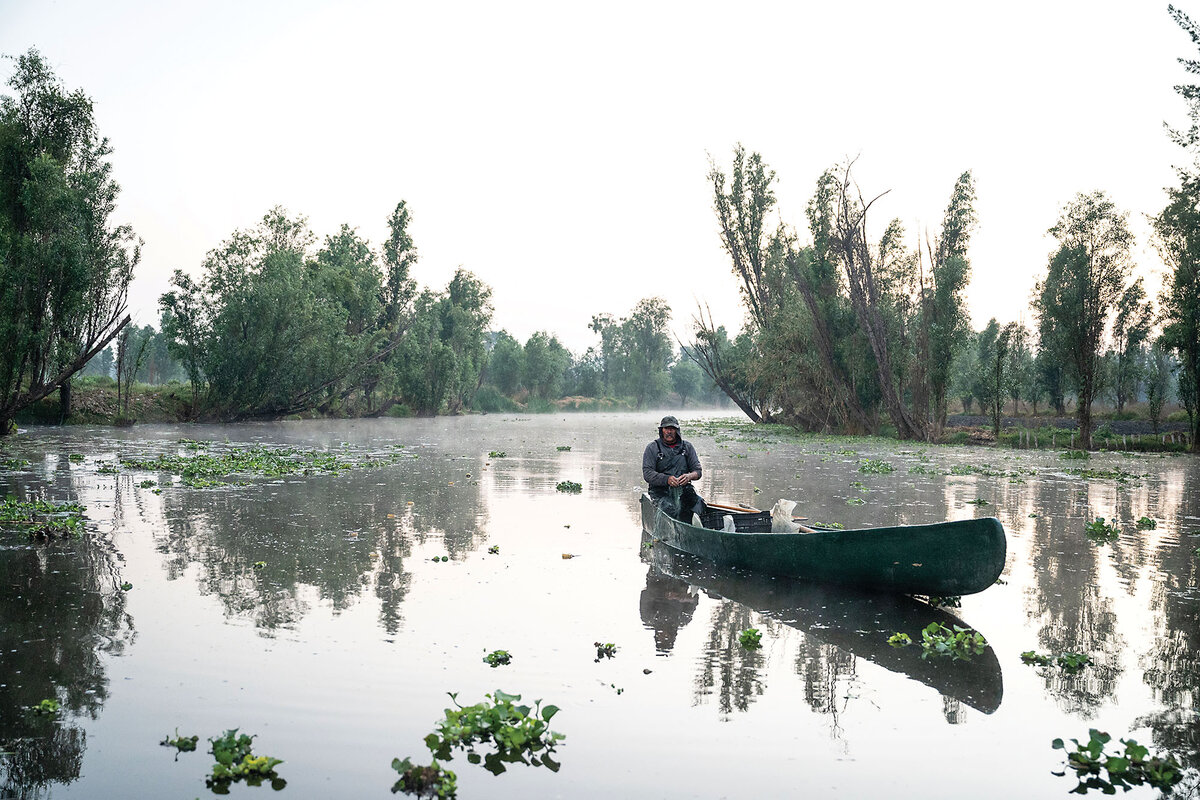
- Quick Read
- Deep Read ( 2 Min. )
-
Whitney Eulich Special correspondent
The canals in the borough of Xochimilco are part of a UNESCO World Heritage Site. They weave through chinampas, the floating gardens built by layering reeds and tree branches and covering them with mud.
For decades, Xochimilco has been popular with weekend revelers and tourists riding on colorful wooden boats called trajineras. Passengers can take in the wildlife, like herons and black ibis, that traverse the waterways or simply soak up the sunshine, sprawled out on the boat’s edge.
But it’s not all about the fiesta. Scientists are active in the chinampas, where they’re racing against urban sprawl and development to try to protect the habitat of an endangered amphibian, the axolotl. In recent years, there has been a growing focus on teaming up with farmers and others who work on the chinampas to restore the beloved salamander’s habitat. That has come hand in hand with efforts by farmers and community organizations to reclaim abandoned chinampas and to reintroduce the historic farming techniques of the city’s ancient breadbasket.
Expand the story to see the full photo essay.
Floating gardens offer a glimpse of Mexico City’s past
Mexico City might be best known as a modern megalopolis, bustling with millions of residents, but visitors don’t have to go far to glimpse its ancient past. In the south sits a network of human-made waterways, the remains of a vast transit system used by the Aztecs to move people and products like food around their empire.
Today, the canals in the borough of Xochimilco are part of a UNESCO World Heritage Site. They weave through chinampas, the floating gardens built by layering reeds and tree branches and covering them with mud.
For decades, Xochimilco has been popular with weekend revelers and tourists riding on colorful wooden boats called trajineras. Passengers can take in the wildlife, like herons and black ibis, that traverse the waterways; purchase quesadillas or grilled corn smothered in mayo, chili powder, and lime from food-vendor canoes; pay for live bands (also moving by boat) to croon ranchero or mariachi ballads for them; or simply soak up the sunshine, sprawled out on the boat’s edge.
But it’s not all about the fiesta. Scientists are active in the chinampas, where they’re racing against urban sprawl and development to try to protect the habitat of an endangered amphibian, the axolotl. In recent years, there has been a growing focus on teaming up with farmers and others who work on the chinampas to restore the beloved salamander’s habitat. That has come hand in hand with efforts by farmers and community organizations to reclaim abandoned chinampas and to reintroduce the historic farming techniques of the city’s ancient breadbasket.





For more visual storytelling that captures communities, traditions, and cultures around the globe, visit The World in Pictures.

The Monitor's View
Building peace by disrupting lies
- Quick Read
- Deep Read ( 2 Min. )
-
By the Monitor's Editorial Board
Surveys of public attitudes about democracy in Africa reveal a contradiction. Growing majorities call for government accountability, yet opposition to military rule has weakened.
One explanation for this is disinformation. Sophisticated campaigns of deception have increased fourfold across nearly 40 countries on the continent since 2022. They attack the credibility of elections, undermine health systems, and promote autocratic leaders. Russia is behind nearly half of them.
A new voice has now pierced that fog of dishonesty. “I helped keep my country in chaos,” said Ephrem Yalike Ngonzo, a journalist in the Central African Republic paid to spread false information provided by a Russian contact. “I want to denounce everything, to make amends, to free myself from my shame and my regrets,” he told the French paper Le Monde last week.
Mr. Ngonzo offered a detailed, inside account of how Moscow cultivates African journalists and activists through the Wagner paramilitary group and other agents.
When a lie is exposed, the world is no longer quite the same. Mr. Ngonzo has marked a route for others from dishonesty to conscience that the sowers of disinformation may note. Motivated by contrition, he is “no longer afraid.”
Building peace by disrupting lies

Surveys of public attitudes about democracy in Africa reveal a contradiction. “Growing majorities call for government accountability and the rule of law,” Afrobarometer reports, yet “Opposition to military rule has weakened.”
One not-so-hidden explanation for this is disinformation. The Africa Center for Strategic Studies in Washington has tracked a fourfold increase in sophisticated campaigns of deception across nearly 40 countries on the continent since 2022. They attack the credibility of elections, undermine health systems, and promote autocratic leaders. Russia is behind nearly half of them.
A new voice has now pierced that fog of dishonesty. “I helped keep my country in chaos,” said Ephrem Yalike Ngonzo, a journalist in the Central African Republic paid to spread false information provided by a Russian contact. “I want to denounce everything, to make amends, to free myself from my shame and my regrets,” he told the French paper Le Monde last week.
Societies that have turned to truth commissions to chart healing paths out of conflict have sometimes held up remorse as a standard for judging the sincerity of people atoning for the harm they have caused. Mr. Ngonzo’s desire “to make amends” points to what some experts in conflict mediation see as a deeper, more transformative commitment.
“Remorse is a genuine empathy-based expression of one’s regret over hurting someone else,” clinical psychologist Dr. George Simon has observed. “Contrition is that very rare but absolutely essential feature of changing one’s life for the better. It requires a true metanoia or ‘change of heart.’ And even more importantly, it requires work – a lot of very hard, humble, committed work.”
Contrition may be the common element in the diversity of conflict-solving approaches that turn perpetrators of harm into restorers of community. That includes former guerrillas in Colombia now protecting farmers and forests and gang members working as conflict disrupters in Chicago.
Mr. Ngonzo offered a detailed, inside account of how Moscow cultivates African journalists and activists through the Wagner paramilitary group and other Russian agents. They are lured with money and then entrapped in fear, he explained. Convinced of the harm he was causing, he slipped away quietly, arriving in Paris in June after moving furtively through neighboring African countries. He was helped onward by European civil society groups that defend whistleblowers in Africa.
When a lie is exposed, the world is no longer quite the same. Mr. Ngonzo has marked a route for others from dishonesty to conscience that the sowers of disinformation may note. Motivated by contrition, he is “no longer afraid.”

A Christian Science Perspective
Each weekday, the Monitor includes one clearly labeled religious article offering spiritual insight on contemporary issues, including the news. The publication – in its various forms – is produced for anyone who cares about the progress of the human endeavor around the world and seeks news reported with compassion, intelligence, and an essentially constructive lens. For many, that caring has religious roots. For many, it does not. The Monitor has always embraced both audiences. The Monitor is owned by a church – The First Church of Christ, Scientist, in Boston – whose founder was concerned with both the state of the world and the quality of available news.
Thanks for being able to give
- Quick Read
- Read or Listen ( 3 Min. )
-
By Susan Booth Mack Snipes
As we recognize that the nature of God’s creation is entirely good, we’re able to give generously, without suffering from negative repercussions.
Thanks for being able to give
I felt utterly exhausted and was hoping to nap before continuing with my second nonprofit event of the day, but I couldn’t get my thoughts to quiet down. “Has anyone really appreciated all the labor and out-of-pocket expense this is costing me? Is there a simpler way to do things? Have I taken on more than I can bear?”
Then cutting across this barrage of negativity came the strong message, “Gratitude and love should abide in every heart each day of all the years” (“Manual of The Mother Church,” p. 60). I recognized this as part of a By-Law from the slim volume of guidance Mary Baker Eddy gave her church, The First Church of Christ, Scientist, to help its members stay in the letter and the spirit of love for God and their fellow man. While I am well familiar with this By-Law, this time it came with new force, as if saying “every moment of every day of all the years.”
It struck me that stricter obedience to this divinely inspired idea would help lift me out of this malaise, as I’ve experienced in the past. So, I began to be grateful that I could give, realizing what a privilege it is to serve others, how precious each one we work with is, and how the perfect support for our worthy undertakings comes forth from God. Within 15 minutes I got up feeling refreshed, energized, and able to answer a call for help that had just come in.
Christ Jesus identified the unfailing benefit of generosity when he bid his followers, “Give, and it shall be given unto you; good measure, pressed down, and shaken together, and running over, shall men give into your bosom. For with the same measure that ye mete withal it shall be measured to you again” (Luke 6:38). Giving that flows freely in response to God’s guidance does not and cannot deplete us. Gratitude helps us recognize this. We stop measuring the transaction – how much it has cost us in time, effort, or money – and trust that God’s law of mutual blessing applies to every act of generosity.
Mary Baker Eddy, who established this news organization, elucidates this law of blessing in her primary work, the textbook of Christian Science, “Science and Health with Key to the Scriptures”: “In the scientific relation of God to man, we find that whatever blesses one blesses all, as Jesus showed with the loaves and the fishes, – Spirit, not matter, being the source of supply” (p. 206).
She is referencing a powerful demonstration of this law, in which Christ Jesus fed over 5,000 people with just five loaves of bread and two fish (see Matthew 14:15-21). He understood that every bit of the good that we see evidenced in our day-to-day lives is but a hint or a symbol of the one wholeness of good that is the very nature of the one infinite God.
Instead of disparaging the small amount of good the bread and fish represented, he gave thanks to God for this evidence, and his disciples gave it out to the multitude of people that had followed him into the desert. Everyone was fed, and there were even 12 baskets of leftovers gathered up.
This may seem miraculous to the human mind, which bases its sense of reality on a finite, material, particle theory of the universe. But Christian Science presents an infinite, unfolding, spiritually mental premise of existence.
Just as there’s an uncountable amount of numbers, limitlessly available for daily usage, the ideas of infinite Mind cannot run out or be used up. In fact, as these ideas are embraced, applied, and shared, they are magnified and more abundantly manifested practically.
Much the way the sun shining on a river of ice frees it from its solid state and allows it to flow, God’s spiritual ideas, poured into consciousness, free up resources for us to use and share. It doesn’t matter whether the need is for food, strength, financial support, time, comfort, or healing inspiration.
This year, as Thanksgiving approaches and I’m taking stock of what I’m grateful for, I’m shouting a “hallelujah!” for being able to give, knowing that “whatever blesses one blesses all,” including me.
We are all in a position to fearlessly give of ourselves in small and large ways, and just think of the infinite resources of strength and abundance that God makes available to us. And just think of the spiritual “Thanksgiving leftovers” we can all gather up together!

Viewfinder
By a whisker
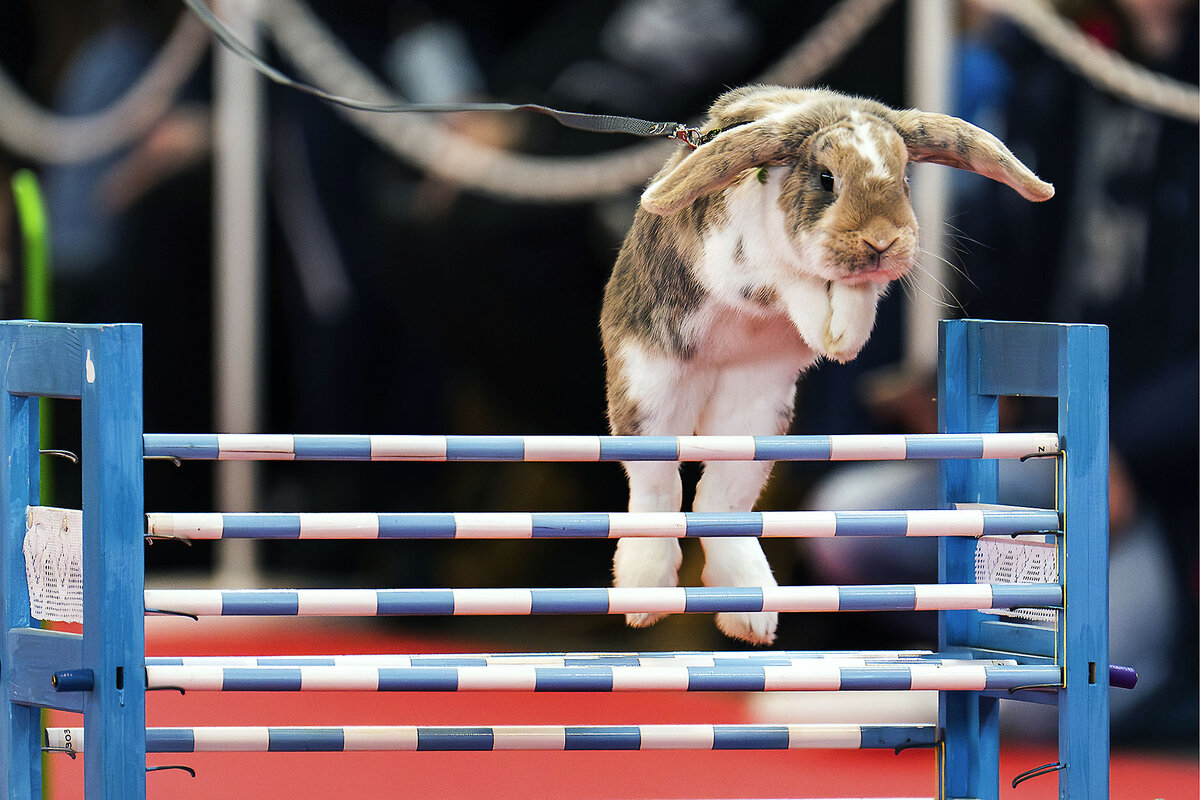
A look ahead
We’re glad you joined us today. Tomorrow, be sure to spend some time with Stephen Humphries’ story on Alice Loxton, a 20-something British historian who is making history cool again. She has millions of young followers on TikTok and Instagram, and her new book, “Eighteen,” is a No. 1 bestseller in the United Kingdom. You may want to follow her!



